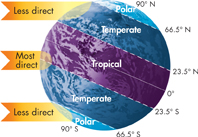Solar Energy and the Greenhouse Effect The main force that shapes our climate is solar energy that arrives as sunlight and strikes Earth's surface. Some of that energy is reflected back into space, and some is absorbed and converted into heat. Some of that heat, in turn, radiates back into space, and some is trapped in the biosphere. The balance between heat that stays in the biosphere and heat lost to space determines Earth's average temperature. This balance is largely controlled by concentrations of three gases found in the atmosphere—carbon dioxide, methane, and water vapor.
As shown in Figure 4–1, these gases, called greenhouse gases, function like glass in a greenhouse, allowing visible light to enter but trapping heat. This phenomenon is called the greenhouse effect. If greenhouse gas concentrations rise, they trap more heat, so Earth warms. If their concentrations fall, more heat escapes, and Earth cools. Without the greenhouse effect, Earth would be about 30° Celsius cooler than it is today. Note that all three of these gases pass in and out of the atmosphere as part of nutrient cycles.
VISUAL ANALOGY
THE GREENHOUSE EFFECT

FIGURE 4–1 Greenhouse gases in the atmosphere allow solar radiation to enter the biosphere but slow down the loss of reradiated heat to space. Use Analogies What part of a greenhouse is analogous to the greenhouse gases in Earth's atmosphere?
dLatitude and Solar Energy Near the equator, solar energy is intense as the sun is almost directly overhead at noon all year. That's why equatorial regions are generally so warm. As Figure 4–2 shows, the curvature of Earth causes the same amount of solar energy to spread out over a much larger area near the poles than near the equator. Thus, Earth's polar areas annually receive less intense solar energy, and therefore heat, from the sun. This difference in heat distribution creates three different climate zones: tropical, temperate, and polar.
The tropical zone, or tropics, which includes the equator, is located between 23.5° north and 23.5° south latitudes. This zone receives nearly direct sunlight all year. On either side of the tropical zone are the two temperate zones, between 23.5° and 66.5° north and south latitudes. Beyond the temperate zones are the polar zones, between 66.5° and 90° north and south latitudes. Temperate and polar zones receive very different amounts of solar energy at different times of the year because Earth's axis is tilted. As Earth revolves around the sun, solar radiation strikes different regions at angles that vary from summer to winter. During winter in the temperate and polar zones, the sun is much lower in the sky, days are shorter, and solar energy is less intense.


FIGURE 4–2 Climate Zones Earth's climate zones are produced by unequal distribution of the sun's heat on Earth's surface. Polar regions receive less solar energy per unit area, and so less heat, than tropical regions do. The tilt of Earth's axis causes the distribution of sunlight to change over the course of the year.
ddTable of Contents
- Formulas and Equations
- Applying Formulas and Equations
- Mean, Median, and Mode
- Estimation
- Using Measurements in Calculations
- Effects of Measurement Errors
- Accuracy
- Precision
- Comparing Accuracy and Precision
- Significant Figures
- Calculating With Significant Figures
- Scientific Notation
- Calculating With Scientific Notation
- Dimensional Analysis
- Applying Dimensional Analysis




